Find the Versatility of Missionary Chairs
Missionary chairs are specialized seating solutions that combine the comfort of individual chairs with the unified appearance of traditional pews. These chairs can be connected to form continuous rows or used as standalone seating, offering flexibility for various spaces.
| What Are Missionary Chairs? | Key Features |
|---|---|
| Specialized worship seating that crosses over into home décor | • Stackable design |
| Individual chairs that can connect to form pew-like rows | • Magnetic or clip connectors |
| Combines traditional aesthetics with modern functionality | • Cold-cured foam for comfort |
| Available in solid wood (oak/alder) or steel frame options | • Optional accessories (kneelers, book racks) |
Missionary chairs represent the perfect fusion of form and function, bringing the warm aesthetic of mission-style furniture into both worship spaces and modern homes. With their clean lines and emphasis on natural materials, these chairs pay homage to the Arts & Crafts movement while meeting contemporary needs for flexibility and comfort.
What makes these chairs unique is their ingenious design that allows them to transform from individual seating into connected rows that mimic traditional pews. This versatility makes them ideal for multi-purpose spaces where seating arrangements need to change frequently.
I'm Mortuary Cooler, and throughout my career supplying specialized equipment to funeral homes and houses of worship, I've seen how missionary chairs can transform spaces with their practical design and adaptability. My experience with missionary chairs spans various settings, from traditional sanctuaries to modern multi-purpose facilities.
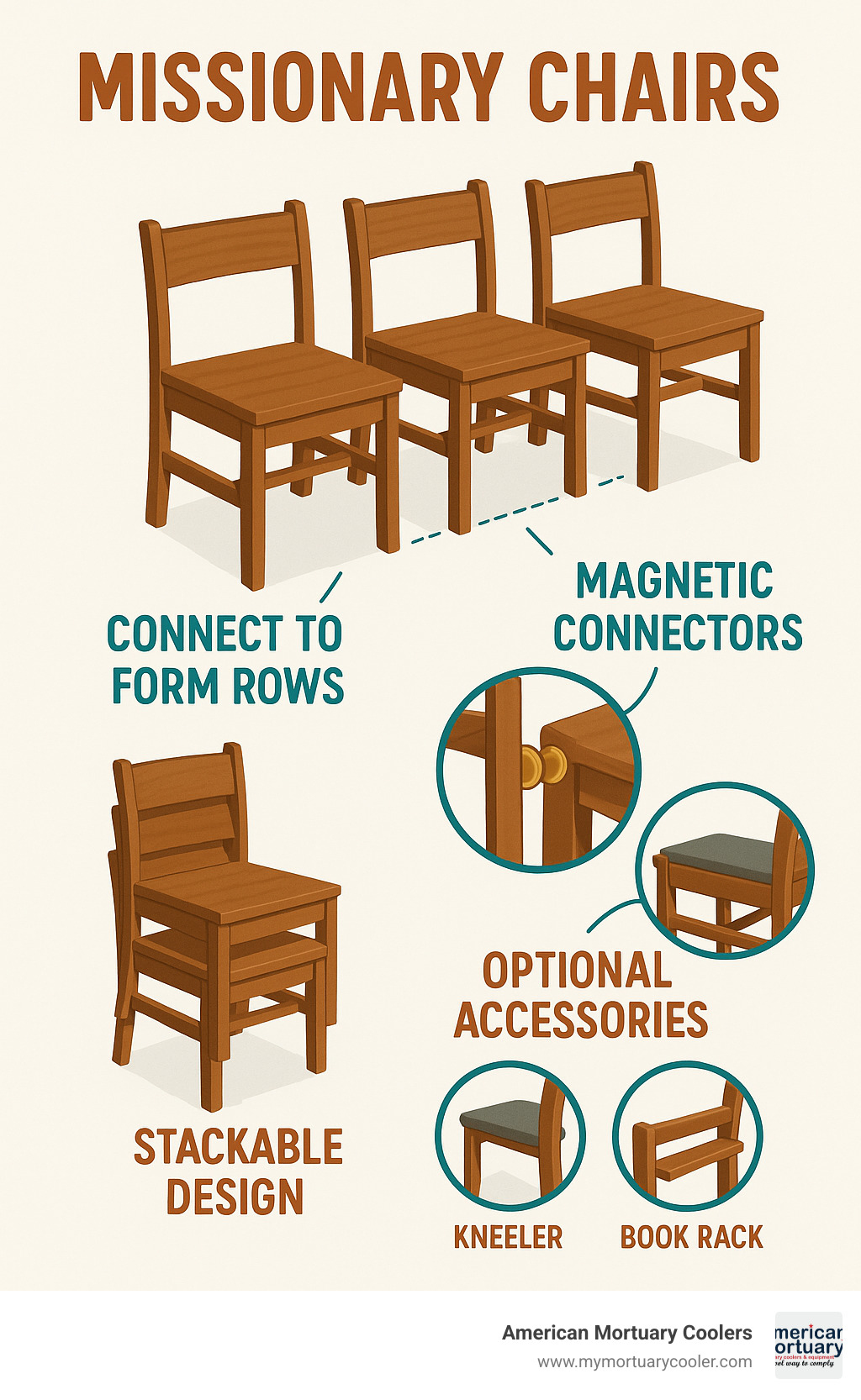
Missionary Chairs 101: Definition & History
The story of missionary chairs begins where practicality meets reverence. While traditional pews anchored worshippers in place for centuries, these innovative chairs emerged as a breath of fresh air for congregations craving flexibility without sacrificing that special sense of sacred space.
Back in the early 1900s, as religious groups established missions and smaller worship spaces, they needed furniture that could move with them. These early missionary chairs were born from necessity—designed to be portable so worship leaders could quickly create gathering spaces that could transform as needed.
What's fascinating is how these purely functional pieces evolved alongside the Arts & Crafts movement, embracing those beautiful clean lines and honest craftsmanship we associate with quality furniture. Over time, simple portable chairs became something more meaningful—pieces that honor tradition while cleverly solving modern problems.
Today's missionary chairs represent this beautiful journey—they're modular worship furniture that connects individual seats into continuous rows, creating that familiar communal feeling of pews while maintaining the flexibility that modern spaces demand.
Origins of Mission Style Furniture
The soul of modern missionary chairs owes a tremendous debt to Gustav Stickley, that pioneering spirit of the American Arts & Crafts movement in the early 1900s. Stickley championed furniture that spoke of honesty—straightforward construction, visible joinery, and minimal decoration—a refreshing departure from those fussy Victorian pieces everyone's grandmother treasured.
His philosophy was beautifully simple: let the materials speak for themselves. As Stickley himself put it, "Simplicity is the keynote of all true art, of all good taste, of all sound judgment."
This approach gave us furniture built primarily from solid wood—particularly oak, celebrated for its striking grain patterns and remarkable durability. Rather than hiding the natural beauty of materials beneath elaborate carvings, mission style furniture proudly showcased the wood's character through thoughtful craftsmanship.
These timeless design principles live on in today's missionary chairs, especially those crafted from solid oak or alder. Their clean lines and emphasis on quality materials make them feel right at home in both worship spaces and living rooms—a testament to the enduring appeal of honest design.
How Missionary Chairs Differ from Other Seating
What makes missionary chairs truly special is their clever design that bridges two worlds. Unlike your standard dining chair or office seating, these chairs feature ingenious detachable rows—allowing individual seats to connect seamlessly into continuous seating that feels remarkably like traditional pews.
This magic happens through various thoughtful mechanisms: invisible magnetic connectors that join chairs without clunky hardware, discrete clip-based "gangers" that keep everything perfectly aligned, or interlocking frames that create stable, unified rows. The result? The community feel of a pew with the flexibility of individual seating.
Missionary chairs are thoughtfully designed with home-scale sizing, striking that perfect balance between institutional function and residential comfort. They feel just as appropriate in your living room as they do in a sanctuary, with proportions that prioritize both comfort and space efficiency.
As one manufacturer beautifully puts it, "The chair is a pew and the pew is a chair"—capturing the dual nature of these versatile seating solutions. This unique quality allows spaces to transform from formal rows for services to casual groupings for fellowship activities in minutes.
Unlike standard home furniture, missionary chairs incorporate features specifically designed for extended comfort: contoured backs that support you through longer seated periods, reinforced frames built for the demands of continuous use, and optional accessories like book racks or kneelers that can be added or removed as needed.
This thoughtful versatility makes missionary chairs uniquely positioned to bridge the gap between institutional and residential furniture—offering the best qualities of both worlds in one beautiful, functional package.
Anatomy & Benefits: Features, Materials & Comfort
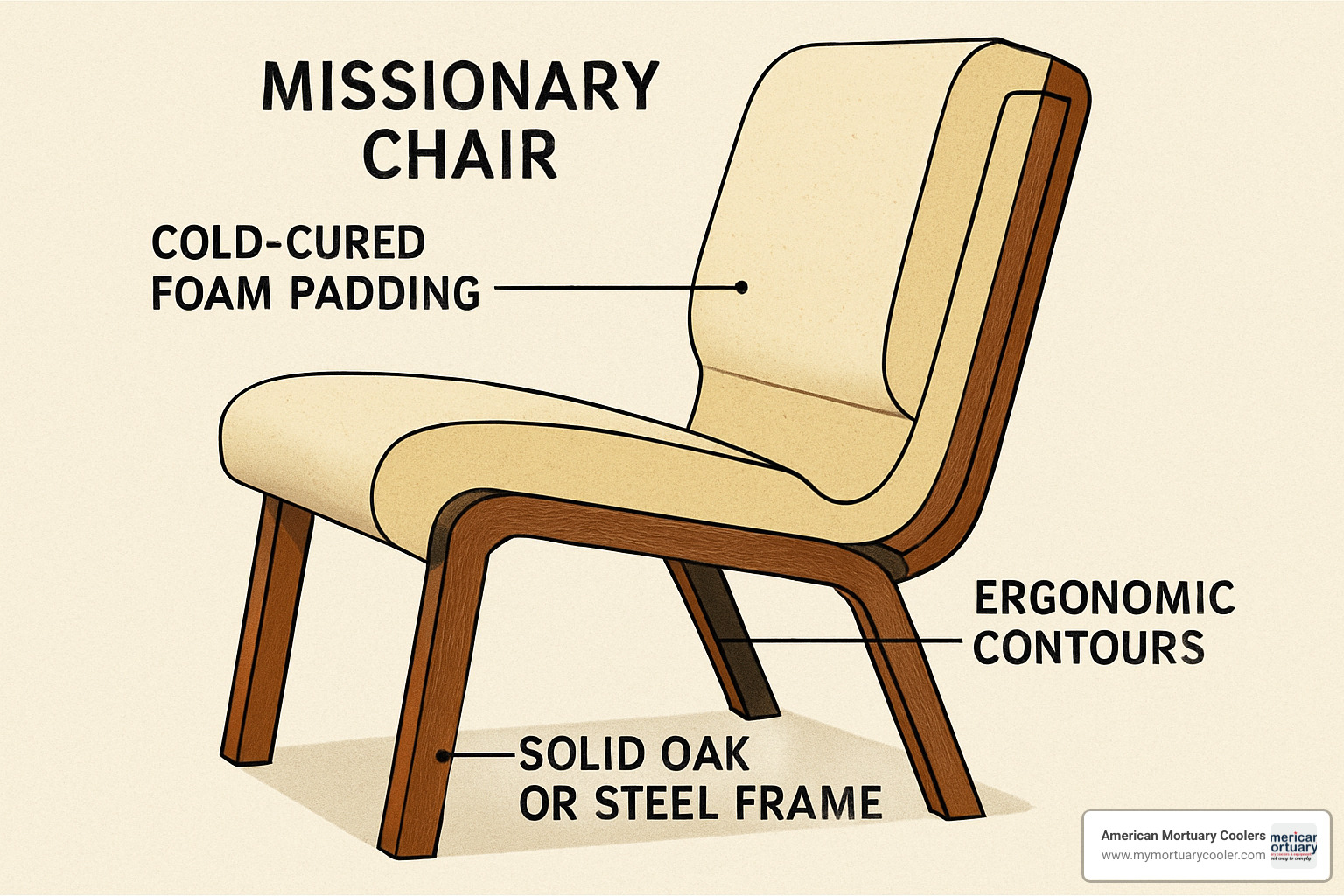
When you sink into a well-made missionary chair, you're experiencing generations of thoughtful design refinement. These aren't just places to sit—they're carefully engineered comfort zones that support your body through everything from Sunday services to family game nights.
The secret to their exceptional comfort? Most quality missionary chairs feature cold-cured foam that maintains its shape and supportive qualities for years. Unlike the cushions in your average dining chair that flatten after a few months, this specialized foam bounces back time and again, offering consistent support whether it's your first sit or your five-hundredth.
Beneath that cushioning, you'll find either gorgeous solid hardwoods like oak and alder or incredibly sturdy steel frames. I've seen manufacturers proudly demonstrate their metal-framed chairs supporting over 1,500 pounds—that's durability you can trust for decades of gatherings.
What makes these chairs truly special are the thoughtful extras that improve both function and comfort. Fold-away kneelers offer versatility for worship while saving space when not needed. Those handy hymnbook racks that hold your worship materials on Sunday? They're perfect for storing magazines, remote controls, or tablets the rest of the week. Some models even include hooks for hanging purses or jackets—practical touches that make life a little easier.
Beyond individual comfort, missionary chairs create a unique community feel that's hard to replicate with other seating options. They bridge the gap between isolated chairs and continuous pews, offering personal space while maintaining a sense of togetherness. It's this balance that makes them perfect for both sacred spaces and family living rooms.
Missionary Chairs Features & Ergonomic Benefits
The human back wasn't designed for extended sitting, yet modern life often demands exactly that. Quality missionary chairs address this challenge with contoured backrests that provide crucial lumbar support, helping maintain proper spinal alignment during longer services or family gatherings.
"All our padded chairs come with cold-cured foam, the industry standard for comfort and reliability," explains ComforTek, one of the leading manufacturers in this space. This isn't just marketing talk—the difference is immediately noticeable when you compare these chairs to standard options.
True inclusivity means comfortable seating for everyone, which is why many missionary chair lines include bariatric options. ChairsForWorship's Meridian chair, for instance, is weight-rated for over 800 pounds, ensuring everyone can participate in community gatherings with dignity and comfort.
For those concerned about indoor air quality (particularly important in spaces where many people gather), look for chairs with MAS certification. This standard ensures the materials used won't off-gas harmful chemicals—something particularly important in enclosed spaces like sanctuaries or small apartments.
The comfort extends to thoughtful details like waterfall seat fronts that reduce pressure on the backs of your thighs, breathable upholstery that prevents that uncomfortable "stuck to the chair" feeling during longer sits, and height-optimized designs that encourage proper posture naturally. These aren't just chairs—they're ergonomic havens.
Materials & Construction Methods
When shopping for missionary chairs, you'll typically choose between steel or wood construction, each offering distinct advantages beyond mere appearance.
Steel-framed chairs use 16-gauge cold-rolled steel—the same material trusted in applications where failure isn't an option. These frames often employ t-nut assembly, where threaded metal inserts are permanently embedded in the frame. This creates incredibly secure connections that won't loosen over time, even with daily use and frequent moving.
Wood construction models showcase the natural beauty of solid oak or alder. As one European craftsman told me, these chairs are "characterized by infinite durability, resilience and natural beauty." There's something timelessly appealing about the warm glow of natural wood grain that synthetic materials simply can't replicate.
The upholstery options have come a long way from the scratchy fabrics of old church chairs. Today's missionary chairs feature Duraweave fabrics that resist stains and wear, commercial-grade textiles tested to withstand 20,000+ rub cycles, and moisture barriers that protect the underlying foam from spills and humidity—particularly important for chairs that might serve multiple generations.
Sustainability has become a priority for many manufacturers. From FSC-certified wood sourcing to zero-waste manufacturing processes, companies like ComforTek proudly maintain their certification as "green suppliers committed to environmental responsibility." When your seating choice aligns with your environmental values, sitting comfortably takes on an additional dimension of satisfaction.
Comfort, Community & Connection in Worship and Home
There's a profound truth that architects of gathering spaces understand: physical comfort directly influences our ability to connect with others and focus on what matters. Missionary chairs recognize this relationship, creating seating that supports both body and community.
These chairs brilliantly resolve what industry experts call "the pew vs. chair debate." They offer the connected feeling of traditional pews while maintaining the individual comfort and flexibility of separate seating. You can arrange them in semicircles that foster conversation, traditional straight rows for more formal occasions, intimate clusters for small group discussions, or with wider spacing for improved accessibility.
The acoustic properties of missionary chairs strike a perfect middle ground that many interior designers overlook. Unlike fully upholstered furniture that absorbs sound (potentially deadening music or spoken word), or hard wooden pews that create too much reverberation, these chairs support clear acoustics whether you're enjoying a sermon, a chamber music performance, or family conversation.
Perhaps the most heartwarming benefit I've witnessed is how missionary chairs create truly inclusive spaces. Their modular nature makes it easy to accommodate wheelchairs, create wider spacing for those who need it, or incorporate specialized seating without disrupting the overall aesthetic of the room.
As one church leader shared after replacing their old fixed pews, "We've seen increased participation from members with mobility challenges who previously found our fixed pews difficult to steer." That same inclusive benefit translates beautifully to home settings, where accommodating guests with varying needs shows true hospitality.
At American Mortuary Coolers, we appreciate the importance of thoughtfully designed furniture that serves specific purposes. Just as our mortuary equipment is crafted for durability and function, these missionary chairs represent the perfect marriage of purpose-built design and timeless comfort. Whether in your sanctuary or your living room, they create spaces where people can gather comfortably and connect meaningfully.
Check out the Fellowship Chair for examples of how these versatile seating options can transform your space.
Flexibility & Functionality: Missionary Chairs vs Traditional Pews
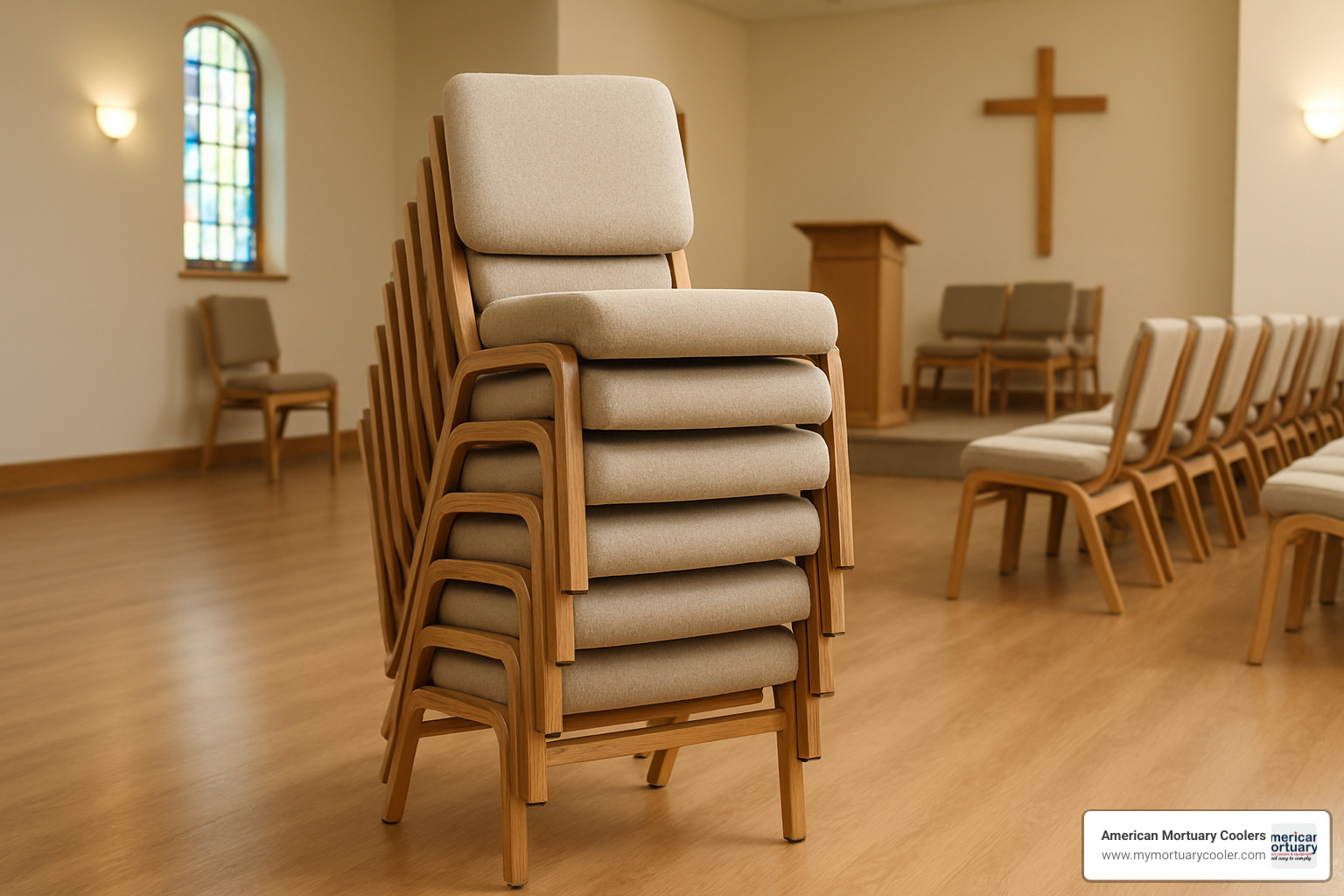
When it comes to seating, the age-old debate between tradition and practicality often boils down to a simple question: pews or chairs? While beautiful wooden pews carry the weight of history and tradition, missionary chairs bring a breath of fresh air to both sacred spaces and modern homes with their remarkable versatility.
What makes these chairs truly special is how they bridge the gap between the past and present. You get the unified, communal feel of traditional seating while enjoying the freedom to transform your space at a moment's notice.
| Feature | Missionary Chairs | Traditional Pews |
|---|---|---|
| Reconfiguration | Can be rearranged in minutes | Fixed in place |
| Storage | Stackable (typically 8-10 high) | Cannot be stored |
| Comfort | Individual ergonomic seating | Shared flat surface |
| Accessibility | Can create aisles of any width | Fixed access points |
| Maintenance | Individual pieces can be replaced | Entire unit requires repair |
| Acoustic Properties | Balanced sound absorption | Often reflective surfaces |
| Cost Effectiveness | Scalable investment | Large upfront investment |
I've seen countless spaces transformed by the simple switch to missionary chairs. A sanctuary that felt cramped and inflexible suddenly becomes a multi-purpose haven. The same space that hosts a formal worship service on Sunday morning can become a community theater by afternoon and a social gathering space by evening.
The magic lies in smart design. Premium models like the ZOE church chair feature magnetic connectivity that creates rows so seamless you'd swear you were looking at traditional pews. Yet with a gentle pull, these unified rows separate into individual seats ready for a completely different arrangement.
For homes, especially those where space comes at a premium, the benefits are just as meaningful. Imagine hosting a dinner party for twelve without permanently dedicating floor space to seating you only need occasionally. When the guests leave, simply stack the chairs and reclaim your living area.
Stackability and Connectivity Explained
The ability to stack missionary chairs is more than just a convenient feature—it's a game-changer for space management. Quality chairs typically stack 8-10 high, changing a roomful of seating into a compact tower that can tuck into a closet or against a wall.
Moving these stacks becomes surprisingly simple with specialized chair dollies. These clever carts typically hold 10-15 chairs and feature smooth-rolling casters with locks for safe transport. I've watched a single person transform a full sanctuary in under 30 minutes—a task that would be impossible with traditional seating.
The connectivity options have come a long way from the clunky ganging mechanisms of years past. Today's missionary chairs connect with an elegance that would impress even the most traditional church elder:
Hidden gangers clip chairs together without any visible hardware, maintaining clean lines and a seamless appearance. Magnetic systems might be my personal favorite—they align and secure chairs with no manual connections required. As ZOE furniture beautifully puts it, their chairs "connect invisibly via built-in magnets to form a uniform pew and can be easily separated."
What impresses me most is how these chairs protect your investment in your space. Most feature non-marking glides or felt pads that treat your floors with respect, whether you have hardwood, tile, or carpet. It's this thoughtful attention to detail that makes missionary chairs suitable for both historic buildings and contemporary homes.
How Missionary Chairs Improve Space Usage
I've seen the change in fellowship halls across the country. Spaces that once served a single purpose suddenly become vibrant centers hosting worship services, community meals, educational activities, and social events—sometimes all in the same day. The quick transitions between activities create a more dynamic, engaged community.
For apartment dwellers and homeowners, the benefits are equally compelling. A dining area can transform into a workout space in minutes. A home office easily converts to accommodate overnight guests. This flexibility is particularly valuable as more people accept minimalist living and multi-functional home environments.
The financial implications shouldn't be overlooked either. When spaces can serve multiple purposes, you maximize the return on your investment in both the facility and the furniture. As one church administrator from Fort Worth shared with us, "We purchased new chairs and successfully sold our old pew chairs through the resale service. Your company is amazing and we are so appreciative!" This highlights not only the practical upgrade but also the potential to recoup costs when making the switch.
Storage efficiency is another significant advantage. While traditional pews occupy the same footprint whether in use or not, missionary chairs can disappear when not needed. I've seen sanctuaries store 200 chairs in less than 100 square feet when stacked efficiently—space that can be used for other purposes or simply left open to create a more spacious environment.
At American Mortuary Coolers, we appreciate quality construction and purpose-built design in all equipment. Just as our mortuary coolers are crafted to serve specific needs with durability and efficiency, well-made missionary chairs bring that same thoughtful engineering to seating solutions. Both transform spaces through intelligent design that respects tradition while embracing modern functionality.
Smart Purchasing: Customization, Pricing, Warranty & Delivery
Shopping for missionary chairs doesn't have to feel overwhelming. With the right information, you can make choices that perfectly match your space while getting the best value for your investment. Let's walk through everything you need to know before making your purchase.
Today's missionary chairs offer impressive customization options that let you create seating that truly feels like yours. Many manufacturers like ComforTek provide interactive design tools (their DesignMix tool is particularly helpful) where you can preview different fabric and frame combinations before committing. This takes the guesswork out of visualizing how your chairs will look in your space.
When it comes to price, quality missionary chairs typically range from $70-$300 per chair. While this might seem higher than basic seating options at first glance, you're investing in furniture that offers exceptional flexibility and durability. Think of it as buying several pieces of furniture in one – the per-year cost makes much more sense when you consider their lifespan.
The warranty is where you can really gauge a manufacturer's confidence in their product. Industry leaders stand behind their work with impressive coverage – typically lifetime warranties on steel frames, 10-15 years on foam, and 5-10 years on upholstery. This kind of protection gives you peace of mind that your investment is secure.
Delivery has come a long way too. Many suppliers now offer white-glove service, where they'll not only deliver your chairs but also assemble them in your chosen room. As one supplier proudly notes, "Free Premium White Glove Delivery includes in-home assembly in the room of choice at no extra charge." This is particularly valuable whether you're furnishing a sanctuary or your home dining room.
For the environmentally conscious, many manufacturers now highlight their sustainability practices – from responsibly sourced materials to energy-efficient production. These green initiatives align perfectly with the values many of us hold dear when making purchasing decisions.
Customization Options for Style & Function
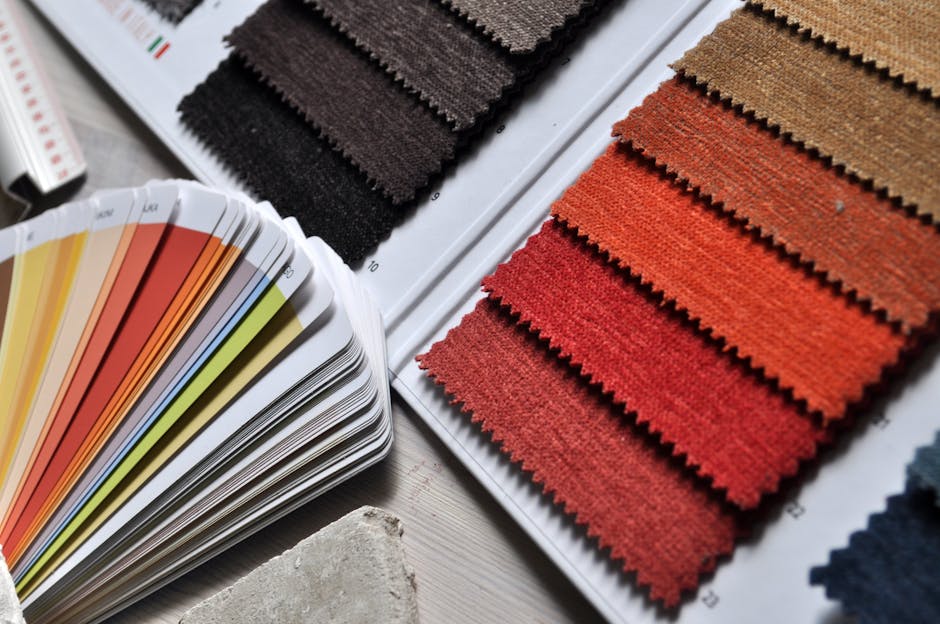
The beauty of missionary chairs lies in how perfectly they can be custom to your unique needs. Fabric selections typically include hundreds of options spanning every color, pattern, and performance characteristic imaginable. This means you can create chairs that complement your existing decor rather than forcing you to redesign around them.
Beyond just looking beautiful, these fabrics offer practical benefits too. Many feature stain-resistant treatments that make them ideal for high-traffic areas, antimicrobial properties for health-conscious environments, moisture barriers to protect the foam inside, and UV-resistant dyes that won't fade in sunny spaces.
The customization doesn't stop at fabrics. Wood frames come in finishes ranging from light natural tones to rich, dark stains, while metal frames offer various powder-coated colors. This means you can coordinate your chairs with existing architectural elements or other furniture pieces for a cohesive look.
Want to make your chairs even more functional? Consider adding armrests for extra comfort, cup holders for convenience during longer events, book racks for worship materials or magazines, or kneelers for traditional worship practices. One manufacturer even offers what they call "hybrid half-armchair comfort with traditional pew connectivity" – a perfect example of how customization can blend tradition with innovation.
For those with very specific design visions, many manufacturers welcome customers to provide their own materials. This custom fabric program ensures you can achieve exact color or pattern matches with your existing decor elements.
Pricing & Cost Factors for Missionary Chairs
Understanding what drives the cost of missionary chairs helps you budget appropriately and recognize value when you see it. The most significant factor is typically material choice – steel frame options generally start at a lower price point than solid wood alternatives. As one industry expert explains, "The engineering and craftsmanship required for solid oak or alder construction naturally commands a premium over steel fabrication."
If you're purchasing multiple chairs, you're in luck. Volume discounts can substantially reduce your per-chair investment. Most manufacturers offer tiered pricing that becomes increasingly advantageous as quantities increase. Typically, you'll see discounts starting around 5-10% for 25-99 chairs, growing to 10-15% for 100-249 chairs, and reaching 15-20% or even custom pricing for orders of 250+ chairs.
For imported options like ZOE's premium European-made chairs (ranging from €390-€1,854 depending on configuration), import duties and shipping costs can influence the final price. Domestically manufactured chairs often avoid these additional expenses but may have higher base pricing due to labor costs.
Other factors that affect pricing include upholstery grade (more durable commercial textiles typically cost more), optional features like armrests or book racks, customization requirements, and the scope of warranty coverage. The good news is that with options starting around $70-$100 for basic models, there's likely a quality chair that fits your budget without compromising on essential features.
Warranty & Durability Assurances
The warranty on your missionary chairs tells you a lot about what to expect in terms of longevity. Industry leaders typically structure their warranties to reflect how different components wear over time.
Frame warranties are usually the most generous – many manufacturers offer lifetime coverage against structural failure. As ComforTek confidently states, they provide a "lifetime warranty on steel frame church chairs." This reflects the exceptional durability of properly engineered structures that should literally last a lifetime.
Foam components usually carry 10-15 year warranty periods, addressing issues like compression or breakdown that would affect comfort over time. Upholstery warranties tend to be shorter, generally spanning 5-10 years depending on the fabric grade, covering abnormal wear, seam failure, and color fastness.
These aren't just arbitrary numbers. Many manufacturers put their chairs through rigorous testing protocols to ensure durability, including weight testing (some models rated for over 1,500 lbs!), cycle testing for moving parts, abrasion testing for fabrics (measured in "double rubs"), and environmental exposure testing for materials.
As one manufacturer beautifully puts it, "Quality workmanship is brought to perfection every day through traditional procedures and relentless precision." This commitment to craftsmanship means your investment will maintain its functionality and appearance for many years, even in demanding environments.
Delivery & Installation Logistics
Getting your missionary chairs from the warehouse to your space is an important part of the purchasing process. Understanding your delivery options helps ensure a smooth experience from order to installation.
Shipping methods typically vary based on your order size. For larger quantities, expect bulk stacks where chairs come stacked and shrink-wrapped for efficient delivery. Smaller orders might arrive in boxed shipping for additional protection, while institutional quantities often come palletized for easy unloading with equipment.
For home deliveries, you'll generally choose between:
- Front-door delivery: The standard service where items are delivered to your entrance
- White-glove delivery: Premium service including indoor placement and assembly
As one supplier explains, "Free Premium White Glove Delivery includes in-home assembly in the room of choice at no extra charge." This service is particularly valuable if you're older, have physical limitations, or simply prefer the convenience of having everything set up for you.
Delivery timeframes depend on whether you're ordering standard or custom chairs. In-stock items with standard shipping typically arrive in 2-4 business days, while white-glove service takes about 2 weeks. Custom orders generally require 4-8 weeks depending on your specifications.
International customers aren't left out either. Many suppliers offer arrangements with freight forwarders, noting that "International customers can ship free to a U.S. freight forwarder." This provides global access to quality missionary chairs without prohibitive shipping costs.
The good news is that most missionary chairs arrive fully assembled or require minimal setup, and their connection systems for creating rows typically feature tool-free designs for quick implementation without specialized equipment.
Frequently Asked Questions about Missionary Chairs
What makes missionary chairs more comfortable than standard dining chairs?
Missionary chairs offer significantly more comfort than typical dining chairs thanks to several thoughtful design elements. The secret starts with cold-cured foam – a specialized material that maintains its supportive properties for years, unlike the standard foam in most residential furniture that compresses over time.
The contoured back design provides ergonomic support that standard dining chairs simply don't offer. As one manufacturer explains, "Our chairs are contoured for ultimate comfort," with shapes that work with your spine's natural curve during extended sitting.
Many models also feature waterfall seat fronts that reduce pressure on the backs of your thighs, wider seat dimensions that comfortably accommodate various body types, and a balanced firmness that provides support without feeling hard. These design elements make missionary chairs perfect for longer seated activities, whether you're hosting a dinner party, working from home, or enjoying movie night with the family.
Are missionary chairs suitable for historical interiors?
Absolutely! The clean, minimalist lines and traditional materials of missionary chairs make them wonderfully adaptable to historical settings. Their design roots in the Arts & Crafts movement share aesthetic principles with many historical architectural styles.
You can select wood finishes that complement existing millwork or antique furniture, with options ranging from light natural tones to rich, dark stains. As one European manufacturer beautifully puts it, their chairs feature "no pompous decorations, just the natural beauty of oak wood," making them appropriate for spaces where period authenticity matters.
For more formal historical settings, look for missionary chairs with traditional details like subtle carved elements or turned legs that connect to classical furniture traditions while maintaining modern comfort.
One of their greatest strengths in historical spaces is the ability to form continuous rows that visually echo traditional pews. This allows these chairs to preserve the visual rhythm of historical worship spaces while introducing needed flexibility – a perfect balance for historic buildings serving contemporary functions.
Can missionary chairs be linked to mimic pews?
Yes! This is actually one of the defining features that makes missionary chairs so special. They can transform from individual seats into continuous, pew-like rows using several innovative connection systems.
The most neat solution is magnetic gangers, which use embedded magnets that automatically align and secure chairs when placed side by side. As ZOE furniture explains, their chairs "connect invisibly via built-in magnets to form a uniform pew and can be easily separated." There's no visible hardware and no manual connection steps required – simply place the chairs next to each other and they connect.
More traditional options include clip-based gangers with discreet metal or plastic connectors that join chair frames together. These systems typically feature tool-free operation, making setup and reconfiguration quick and easy.
The result is seamless rows that provide the unified appearance of traditional pews while maintaining the flexibility to reconfigure your space whenever needed. This clever design resolves what one industry expert calls "the pew vs. chair debate" by offering the best of both worlds.
For home use, this feature is particularly valuable, allowing you to create a cohesive seating arrangement for larger gatherings that can later be separated for everyday use or storage – a versatility that traditional furniture simply can't match.
Conclusion
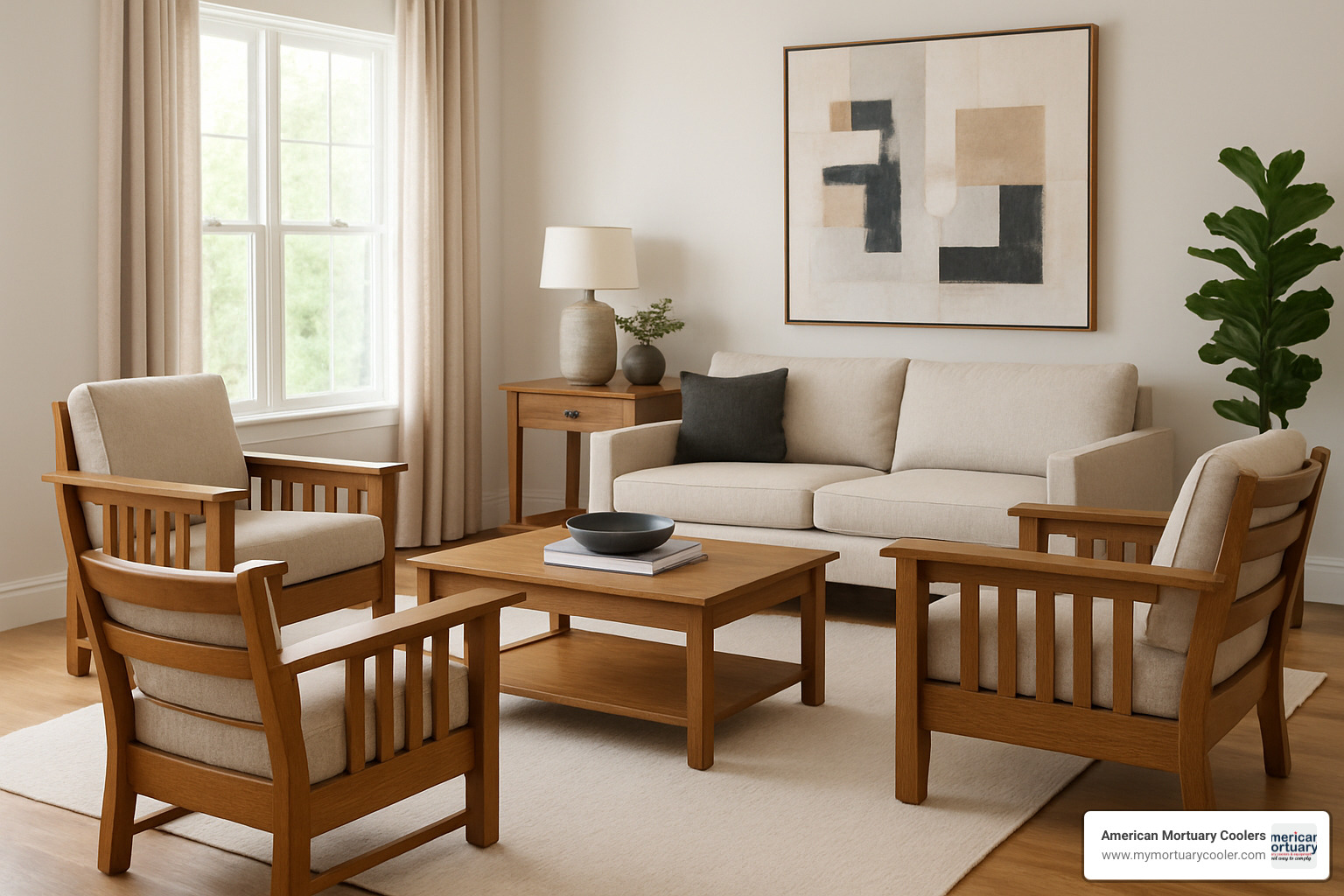
As we've journeyed through missionary chairs, I hope you've come to appreciate these remarkable pieces as I have. They're not just chairs – they're versatile solutions that neatly bridge traditional craftsmanship with modern needs, creating seating that works beautifully in both sacred spaces and family homes.
At American Mortuary Coolers, we may specialize in a different industry, but we deeply understand the value of purpose-built, reliable equipment. Our custom mortuary coolers serve funeral homes with the same dedication to quality that the finest missionary chairs bring to worship spaces and living rooms. Both require thoughtful design, premium materials, and an unwavering commitment to serving specific needs.
When you're selecting missionary chairs for your home, think about how you'll actually use them. Will they primarily stand alone, or do you need that clever connectivity to create pew-like rows for gatherings? The beauty of these chairs is their adaptability – they can transform your space as quickly as your needs change.
Pay attention to the warranty offerings too. Just as we stand behind our mortuary coolers with confidence, quality chair manufacturers back their products with generous guarantees – often lifetime coverage on frames, 10-15 years on foam, and 5-10 years on upholstery. These aren't throwaway pieces; they're investments in your comfort and your home's functionality.
The customization options available today make missionary chairs even more appealing. From rich wood finishes that complement your existing décor to performance fabrics that stand up to family life, you can create seating that's uniquely yours while maintaining that timeless mission-style aesthetic.
I've seen how the right seating transforms spaces – creating environments where people naturally gather, connect, and feel at home. Whether you're furnishing a cozy reading nook or a spacious family room, missionary chairs offer that perfect blend of comfort, durability, and style that makes a house truly feel like home.
For those interested in learning more about our approach to crafting custom solutions for specialized environments, please visit American Mortuary Coolers. While our products serve a different purpose, we share the same philosophy that guides the best missionary chair manufacturers: exceptional quality, thoughtful design, and a deep understanding of our customers' needs.
The right chairs don't just furnish a room – they improve how you live in it. Choose wisely, and enjoy the remarkable versatility that only missionary chairs can provide.